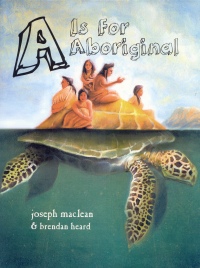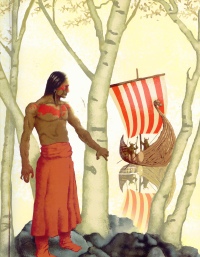| ________________
CM . . .
. Volume XX Number 39. . . .June 6, 2014
excerpt:
The alphabet is highlighted and explored letter by letter with background information on a name, place or facet of First Nations’ history and culture in Canada and beyond our borders. Each letter is accompanied by a full-page illustration that corresponds, illuminates and exemplifies the simple but evocative text and a listing of aboriginal tribal affiliations that begin with that letter. For example, the illustration accompanying the excerpt for R above shows three young males, in complete feathered headdresses and conventional dress, dancing on the prairies in front of three unadorned teepees. The prairie sky and grasslands are illuminated in a bright natural colour palate of blues, browns and golds. Included are four tribal names from Mexico (Raramuri), Restigouche (Mi’kmaq), Roanoke Island (Roanoke) and California (Rumsen). The list of names accompanying the text for the letter is S is quite substantial with over seventy names that includes names that may be surprisingly recognizable as place names for many people unfamiliar with their origins, names such as Saanich, Sechelt, Selkirk, Sooke, and Spokane (Spokan). The illustration for this double page spread is much more dramatic than the previous page, with golds, browns and greens dominating the page. It is a night scene featuring the Sasquatch and four First Nations’ characters, again dressed in historical dress. Several of the letters are conceptualized with landscape illustrations that do not feature any humankind, some are specific to the historical characters highlighted in the poem/text but all of the others, without exception, place the aboriginal peoples in the past rather than the present or even the future. For this reviewer, the illustrations on their own are very powerful and beautifully done, but, taken all together, they paint a completely different picture than the one that is intended by the author and illustrator.
The book also has its own website, http://www.aisforaboriginal.com/, offering a Buy One – Donate One program which has, at its goal, to distribute 20,000 copies of the book to the many families who may not be able to afford purchasing it for themselves. The gathering of broad information in the glossary makes this a constructive purchase for school and public library collections. Recommended. Gail de Vos teaches at the School of Library and Information Studies for the University of Alberta and San Jose State University. She is the author of nine books on storytelling and folklore.
To comment
on this title or this review, send mail to cm@umanitoba.ca.
Copyright © the Manitoba Library Association. Reproduction for personal
use is permitted only if this copyright notice is maintained. Any
other reproduction is prohibited without permission.
NEXT REVIEW |
TABLE OF CONTENTS FOR THIS ISSUE
- June 6, 2014.
AUTHORS |
TITLES |
MEDIA REVIEWS |
PROFILES |
BACK ISSUES |
SEARCH |
CMARCHIVE |
HOME |

 Following the 26 full-page spreads is an annotated glossary of all the tribal names mentioned on the previous pages. Each annotation includes information about the people, past and present, which, in some ways, compensates for the preliminary message given by the illustrations. Prefacing the annotations, in italics, is an explanatory note from the author of his source material for the annotations. He states that “the glossary although extensive is not a definitive list of indigenous people. The list mainly focuses on North America but include the names of a number of indigenous peoples from around the word to provide a more global sense of the depth and range of the 'Aboriginal' story” (no pagination). Interspersed with the annotations are several personal observations and connections from the author, delineated with italics. For example, following the entry for Mi’kmaq (Mikmawisink) is the note: “My mother, Virginia (Doyle) MacLean, an army nurse who served in Europe during WWII, knew many natural herbal remedies that she learned from her mother and grandmother in rural Nova Scotia. My mother told us that her grandmother was adopted by the Mi’kmaq in recognition of her work as herbalist and healer.” The information presented in these annotations is mostly without source notes, gathered from “the author’s personal library, research and records as well as from online resources like Wikipedia...When the information comes from a First Nation, Native American Tribal website or other source it is listed as the specific source.”
Following the 26 full-page spreads is an annotated glossary of all the tribal names mentioned on the previous pages. Each annotation includes information about the people, past and present, which, in some ways, compensates for the preliminary message given by the illustrations. Prefacing the annotations, in italics, is an explanatory note from the author of his source material for the annotations. He states that “the glossary although extensive is not a definitive list of indigenous people. The list mainly focuses on North America but include the names of a number of indigenous peoples from around the word to provide a more global sense of the depth and range of the 'Aboriginal' story” (no pagination). Interspersed with the annotations are several personal observations and connections from the author, delineated with italics. For example, following the entry for Mi’kmaq (Mikmawisink) is the note: “My mother, Virginia (Doyle) MacLean, an army nurse who served in Europe during WWII, knew many natural herbal remedies that she learned from her mother and grandmother in rural Nova Scotia. My mother told us that her grandmother was adopted by the Mi’kmaq in recognition of her work as herbalist and healer.” The information presented in these annotations is mostly without source notes, gathered from “the author’s personal library, research and records as well as from online resources like Wikipedia...When the information comes from a First Nation, Native American Tribal website or other source it is listed as the specific source.”